Bubble canopy
A bubble canopy is a canopy constructed without bracing, for the purpose of providing a wider unobstructed field of view to the pilot, often providing 360° all-round visibility.
The designs of bubble canopies can drastically vary; some, such as on later versions of the F4U Corsair, are built into the upper rear fuselage, while others, like the canopy of the P-51D Mustang and most modern combat aircraft, are built flush with the fuselage, providing unobstructed rear visibility. Although experimented with as early as the First World War, the bubble canopy was introduced to widespread use during the Second World War, being used upon a number of American, British, and Japanese aircraft, commonly fighters.
During the postwar era, the bubble canopy became a common feature of jet-powered fighter aircraft. Outside of combat aircraft, such canopies have also been adopted upon several helicopters and general aviation aircraft, often for roles that benefit from a high level of exterior visibility, such as aerial reconnaissance.
History
The bubble canopy has been in use well before Second World War; a number of experimental bubble canopy designs has been trialled during the First World War era. British aircraft designers developed the Malcolm hood, a bulged canopy, that was first adopted on the Supermarine Spitfire and subsequently other aircraft. However, the British Miles M.20 was amongst the first aircraft designs to feature a true one-piece sliding bubble canopy. Although that aircraft never went into production, the concept of the bubble canopy was later utilised on other British aircraft, such as the Hawker Typhoon and Tempest.
Subsequently, Malcolm hood-style canopies were also later fitted to the North American P-51 Mustang[1] and Republic P-47 Thunderbolt, amongst other aircraft. A well-framed version of an all-around vision canopy was also used on the Imperial Japanese Navy Air Service's well-known Mitsubishi A6M Zero Japanese naval fighter, and different designs, with much less framing than the "Zero" had, were used on the Imperial Japanese Army Air Service's Nakajima Ki-43 Oscar and Nakajima Ki-84 Frank land-based fighter planes.
The Bell 47 helicopter was the first production helicopter certified for civilian use in the United States, and in its Model 47D version, pioneered the "soap bubble"-style canopy for light helicopters – as named by its designer, Arthur M. Young[2] – that it and the 47G model were to become famous for.[3][4] Following after the Bell 47, various other rotorcraft have used bubble canopies, including the Robinson R44,[5] Schweizer S333,[6] and the Mil Mi-24, the later versions of the latter possessing a distinctive tandem cockpit with a "double bubble" canopy that replaced its original angular greenhouse-style cockpit arrangement.[7]
Numerous jet-powered fighter aircraft of the postwar era adopted bubble canopies. One of the more prominent external differences between the ground-attack orientated Hawker Siddeley Harrier and the later British Aerospace Sea Harrier, a navalised fighter derivative of the former, was the adoption of an elevated cockpit within a bubble canopy, granting superior exterior visibility to the pilot.[8] The General Dynamics F-16 Fighting Falcon also adopted a frameless bubble canopy in conjunction with a raised and reclined seat that granted unobstructed forward and upward vision.[9] The canopy of the F-16 comprises a single piece of bird-proof polycarbonate; it lacks the forward bow frame found on many fighters, which is an obstruction to a pilot's forward vision.[10][11] A bubble canopy was also incorporated into the Lockheed Martin F-22 Raptor,[12] and the Eurofighter Typhoon, both being fighters orientated towards the aerial supremacy role.[13]
Specialised aerial reconnaissance aircraft have also made use of bubble canopies. The Edgley Optica incorporates an unorthodox fully glazed forward cabin, intended to provide a high level of exterior vision to its crew; the aircraft has a distinctive appearance due to this cabin, often being referred to as the "bug-eye".[14][15] The bubble canopy has also been adopted within the general aviation sector; the Diamond DA42 is one such aircraft which incorporates such a canopy in some guises, typically intended for reconnaissance work.[16][17] Another general aviation aircraft, the Grob G 120, also features a relatively wide bubble-style canopy.[18] Numerous aircraft within the general aviation category feature such canopies.[19]
Purpose
The purpose of a bubble canopy is to give a pilot a much wider field-of-view than flush, framed "greenhouse" canopies used on early World War II aircraft, such as those seen on early models of the F4U, P-51, the Soviet Yak-1 and earlier, "razorback" P-47 fighters, all with dorsal "turtledecks" integral to their fuselage lines, which left a blind spot behind the pilot that enemy pilots could take advantage of to sneak up on an aircraft.
The open-cockpit design combat aircraft of World War I had narrow fuselages, which often were not tall enough to block visibility to the rear, especially with seating positions that generally elevated the pilot's head well above the cockpit's edges. As planes became larger, heavier and faster, designs had to be made stronger, which often meant a taller rear fuselage, but designers tried to maintain the narrow fuselage for visibility.
However, as speed continued to increase, it became necessary to enclose cockpits – and this, in turn, streamlined aircraft so that they were faster still. Increased "g-loading" during maneuvers forced pilots to wear tight, restrictive shoulder harnesses, and armor plating began to be installed to protect pilots from projectiles coming from behind. These changes denied a pilot the ability to twist around and look directly behind (known as "checking six," or looking at the "six o'clock" position directly to the rear). Mirrors offered some help, but had a narrow field of view.
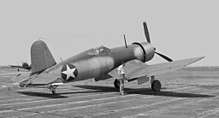
Prior to bubble canopies, some aircraft, such as the P-40 Warhawk, featured a hybrid flush canopy design, combining a narrow rear fuselage with a glass enclosure conforming to the shape of a full-width fuselage - these often had a pair of recessed panels (one per side, behind the openable canopy) in the dorsal "turtledeck" structure, faired-in with framed glazing that was flush to the fuselage surface. This provided increased visibility while still allowing a pilot to keep the canopy closed for greater performance. Examples of such "recessed" rear vision designs were the "greenhouse"-canopied original F4U-1 Corsair as well as the P-40. The bulged Malcolm hood, used for the Spitfire, F4U Corsair, and P-51B and -C Mustangs was another hybrid. While not offering as much visibility to the rear as the P-40 enjoyed, it allowed a pilot more visibility than a flush canopy would.
Examples
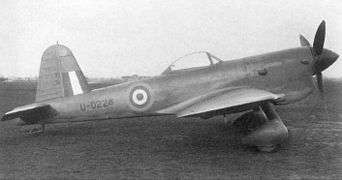 Miles M.20 showing the one-piece frame-less bubble canopy, the whole of which slides rearwards to open
Miles M.20 showing the one-piece frame-less bubble canopy, the whole of which slides rearwards to open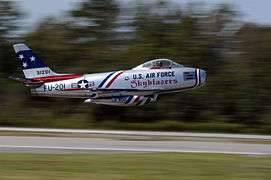 F-86 Sabre
F-86 Sabre- View of a Su-30 MKI cockpit with IRST system
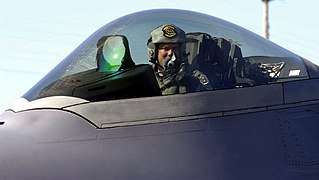 F-22 showing the frameless canopy and the 360° view for the pilot
F-22 showing the frameless canopy and the 360° view for the pilot- The twin bubble canopies of the Mil Mi-24 Hind helicopter
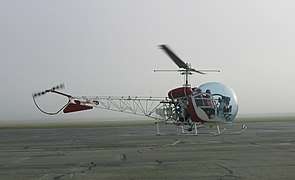 Bell 47G helicopter with its distinctive "soap-bubble" canopy
Bell 47G helicopter with its distinctive "soap-bubble" canopy
References
Citations
- "Malcolm hood", Aero files.
- Arthur M. Young. Arthur Young on the Helicopter (Part 2) (YouTube) (YouTube). Arthur M. Young. Event occurs at 10:15 to 11:45. Retrieved 8 April 2016.
I thought the bubble was a great idea, and we tried it. It consisted of taking a large sheet of Plexiglas, and a plywood form, cut for the final dimension for the outside of the bubble, then heating the Plexiglas, putting it under the plywood form, letting air pressure come up through the middle, and it would blow just like a soap bubble. And, then we had a gauge saying how far to blow, and when it reached that point, we turned off the air pressure.
- Huber, Mark (November 2012). "Ode to the Bubble". Air & Space Magazine.
- Perry, Dominic (21 November 2014). "Rotor club: Our top 10 most influential helicopters". Flight International.
- "Helicopter Rides". ingeniumcanada.org. Retrieved 21 March 2020.
- Norris, Guy (28 January 2003). "Fire Scout takes flight". Flight International.
- "Mi-24 D/W". Casemate Publishing UK. Retrieved 21 March 2020.
- Bull 2004, p. 120.
- "F-16 Fact Sheet". U.S. Air Force. 23 September 2015. Archived from the original on 29 January 2017. Retrieved 25 November 2018.
- Peacock 1997, p. 99.
- "Lockheed Martin F-16 Fighting Falcon." Jane's All The World's Aircraft, updated 21 January 2008. Retrieved: 30 May 2008.
- "Balancing act". Flight International. 9 April 1997.
- Stein and Sandl 2012, p. 166.
- Flight International 12 May 1979, p. 1591.
- Sarsfield, Kate (13 September 2008). "Optica designer seeks manufacturing partners to relaunch aircraft". Flight International.
- Morrison, Murdo (15 July 2009). "Diamond: DA42s shone during RAF's Iraq mission". Flight International.
- Morrison, Murdo (27 March 2009). "Can Diamond shine again?". Flight International.
- Collins, Peter (1 February 2011). "FLIGHT TEST: Grob Aircraft G120TP - Pocket rocket". Flight International.
- Collins, Peter (15 July 2005). "FLIGHT TEST FLY OFF: Evektor SportStar, Flight Design CT, Tecnam Sierra - Sporting heroes". Flight International.
Bibliography
- Bull, Stephen (2004). Encyclopedia of Military Technology and Innovation. Westport, Connecticut: Greenwood Publishing. ISBN 978-1-57356-557-8.
- "Optica—the bug-eyed observer". Flight International. Vol. 115 no. 3660. IPC Business Press. 12 May 1979. pp. 1591–1594 – via Flightglobal archive.
- Peacock, Lindsay. On Falcon Wings: The F-16 Story. RAF Fairford, United Kingdom: The Royal Air Force Benevolent Fund Enterprises, 1997. ISBN 1-899808-01-9.
- Stein, Michael and Peter Sandl. Information Ergonomics. Springer Science & Business Media, 2012. ISBN 3-642258-40-9.